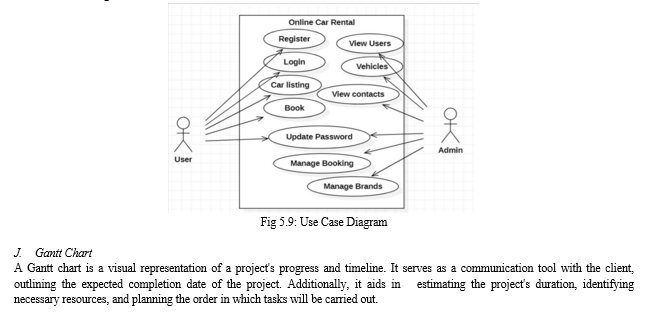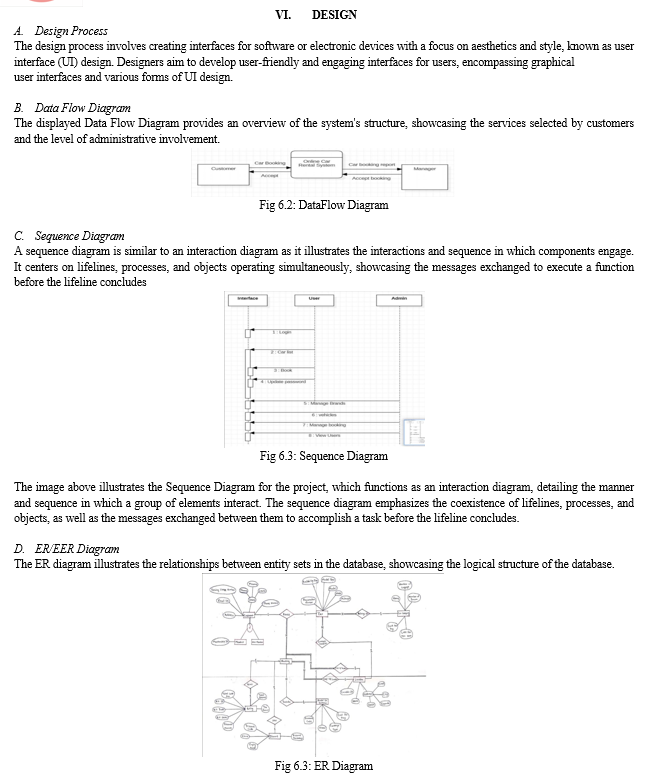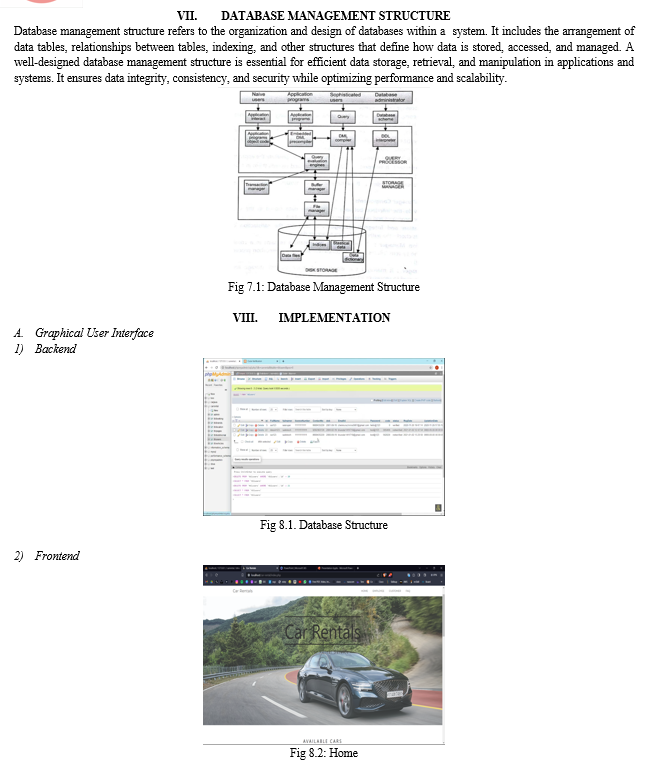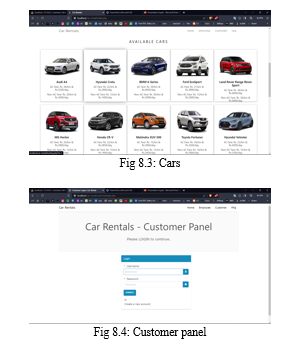Ijraset Journal For Research in Applied Science and Engineering Technology
- Home / Ijraset
- On This Page
- Abstract
- Introduction
- Conclusion
- References
- Copyright
Vehicle Renting System
Authors: Shantanu Nag, Jagrit Saheb, Uday Raj Pillay, Khushi Gupta, Shankar Sharan Tripathi
DOI Link: https://doi.org/10.22214/ijraset.2024.60989
Certificate: View Certificate
Abstract
The development of a vehicle rental system aims to provide customers worldwide with the convenience of booking vehicles online. This integrated system automates manual processes, allowing customers to easily input their vehicle preferences and location. The user-friendly interface of the Super vehicle Rental System enhances user experience, making it simple for customers to interact with the platform. Administrators have the capability to manage rentals, bookings, customer inquiries, and vehicle information efficiently. Customers can access vehicle models, descriptions, and prices, register, and view rental plans through a responsive website accessible on various devices. The system, built using PHP, DBMS, and XAMPP, offers a comprehensive solution for vehicle rental services, ensuring a seamless experience for both customers and administrators.
Introduction
I. INTRODUCTION
In the realm of transportation services, the development of efficient vehicle rental systems plays a pivotal role in addressing the evolving needs of individuals facing financial constraints in vehicle ownership. This research paper delves into the intricacies of a comprehensive vehicle rental system that encompasses three distinct phases. The initial phase focuses on the strategic organization of vehicle rental locations into pools, facilitating the shared utilization of a fleet among pooled outlets. Subsequently, the second phase delves into the meticulous planning of vehicle acquisitions, deliveries to manufacturers, and the geographical redistribution of vehicles across pools over an extended planning horizon. Finally, the third phase revolves around the operational dynamics, where the deployment of the fleet within and among pools is finely orchestrated on a day-to-day basis. Simultaneously, in today's digital age, the necessity for convenient and accessible transportation solutions has become increasingly pronounced. Recognizing this need, a user-centric website has been developed to provide a seamless platform for customers to explore transportation options and effortlessly reach their destinations. Accessible to a diverse demographic encompassing students, working professionals, and individuals seeking transportation services, this website embodies a fusion of customer-centricity and technological advancements within the IT sector. By intertwining user needs with technological innovation, the project aims to not only enhance user experiences but also contribute to the broader business landscape. Emphasizing the pivotal role of the internet as a vital communication conduit for global enterprises, the project underscores its commitment to driving business growth while addressing the urgent transportation requirements of individuals worldwide. Users can engage with the website, browse through a range of available vehicles, seamlessly interact with the online rental system, and leverage the user-friendly interface across various mobile devices, ensuring unparalleled convenience irrespective of their geographical location.
A. It is Designed to Cater to the Needs of Individuals
Who require access to two-wheelers or four-wheelers for transportation when other options such as taxis, autos, or buses are unavailable. Our service is available in both urban and rural areas, providing convenience regardless of location. To utilize our app, users must register as members on our website and place an order for the desired vehicle. This platform offers insights into the effectiveness of our business operations across various regions and communities. Customer satisfaction is our top priority, and we strive to ensure a seamless booking process for users. Customers can easily select vehicles based on their preferences,choosing from a variety of options including colors, mileage, and more.
B. The Vehicle Rental Service Operates in a Straightforward Manner
- Registration: Users visit the website and register by providing basic information such as name, email address, and mobile number. Upon setting a password, the registration process is completed. Subsequently, users can log in using their credentials and access the home page.
- Vehicle Selection and Booking: Users can browse and select the vehicle of their choice. To book a vehicle, users need to specify the booking date, time, vehicle type, and proceed with the payment for the booking.
- Booking Confirmation: Upon successful booking, users receive a detailed receipt containing all the booking information. Additionally, the system sends a receipt to the user's mobile number via SMS.
- Vehicle Pickup or Delivery: Users can either visit the nearby rental office to collect the vehicle, or a company executive can deliver the vehicle to the user's location.
- Document Verification: Upon receiving the vehicle, users are required to undergo a document check for identity and security purposes. This process is conducted by an executive from the rental company.
C. The Benefits of Online Vehicle Rental Services Include
- Ease of Use: Online vehicle rental systems are user-friendly, making it convenient for users to browse, select, and book vehicles with ease.
- Corporate Usage: Companies can utilize online vehicle rental services to provide rental vehicles for their employees, simplifying transportation arrangements for business purposes.
- Range of Options: Online vehicle rental services offer a wide range of vehicles, catering to different preferences and budgets, from economical options to luxury vehicles.
- Time and Effort Saving: Users can save time and effort that would otherwise be spent arranging transportation when they do not have access to their own vehicle.
- Eco-Friendly: By reducing the need for paperwork, online vehicle rental services contribute to environmental sustainability by minimizing paper waste.
- Availability and Accessibility: The software is accessible 24/7 from any location, allowing users to book vehicles at their convenience. This availability enhances the efficiency of service delivery to customers by the management.
II. FUNCTIONAL REQUIREMENTS
Are essential for describing how an application operates internally. They detail the tasks performed by various subsystems within the application. Functional requirements serve as the foundation for developing an application, guiding the implementation process based on the desired application type. In this context, functional requirements address questions related to how the application functions internally, delineating the responsibilities of each subsystem. Understanding the internal workings of the system is crucial for ensuring that the application is user-friendly and operates smoothly. Failure to define functional requirements can lead to unexpected behavior in the application. For instance, in a vehicle rental system, functional requirements may include mechanisms for automatically updating the availability of vehicles. When a customer registers, they may need to verify their account through an email link, with the system automatically saving their registration data for future use. These features streamline the user experience and reduce the need for manual intervention by administrators.
Functional requirements play a pivotal role in creating a program's basic model, ensuring that the application functions effectively and efficiently. By defining how different components of the system interact and operate, functional requirements contribute to the overall usability and reliability of the application.
III. NON-FUNCTIONAL REQUIREMENTS
complement functional requirements by focusing on how the desired functionalities are achieved. These requirements define the characteristics and qualities of the system, rather than specific behaviors or tasks. They address aspects such as performance, security, usability, reliability, and scalability, which are essential for ensuring the overall effectiveness and quality of the application.
In the context of a website for vehicle rental services, non-functional requirements may include:
- User Registration and Verification: Users must register and verify their email address through a verification link sent to their provided email before they can place orders. This enhances security and ensures that only authorized users can access the system.
- User Authentication: Users must log in using their verified email address and password to access their account and place orders. This authentication mechanism safeguards user data and ensures secure access to the system.
- Staff Management: The system should provide detailed information about staff members, including their availability, roles, authorities, positions, and promotions. This helps in efficient staff management and ensures clarity in organizational structure.
- Authorization Levels: Different staff members should have varying levels of authorization based on their roles and responsibilities. This ensures that access to sensitive information and functionalities is restricted to authorized personnel only.
- User Experience: The website should offer a user-friendly interface that makes it easy for users to navigate, search for vehicles, and place orders. This enhances usability and ensures a positive user experience.
Non-functional requirements play a crucial role in shaping the overall operations and performance of the application. By defining these requirements before implementation, developers can prioritize factors that contribute to the system's effectiveness, security, and user satisfaction.
IV. VEHICLE DETAILS
In the context of vehicle details for a rental service application, the information provided about each vehicle is crucial for users to make informed decisions.
Here are the key details typically included:
- Availability We don’t Show the Vehicles which is not available currently in our website. Whenever our vehicles are getting back to us, we update the website list of available vehicles.
- Cost/Km Details of vehicles are available on vehicles section like how much mileage vehicle give under 1 liter petrol or diesel
- Color Various types of colors are available for vehicles you can choose whatever color you like for vehicle.
- Capacity Various range of vehicles are available according to your choice of capacity you can choose you want to get vehicle for family trip or friend’s trip.
- Vehicle Code Vehicle codes are present on every vehicle to make renting process efficient and hassle-free trip.
- Vehicle Name Vehicle’s name is available to see available vehicles in our website and every name is unique for user. They don’t have to confuse.
- Fuel Type Different Vehicles with different fuel types are available according to your choice of fuel both diesel and petrol vehicles are available.
a. Availability: Only vehicles that are currently available are displayed on the website. The list of available vehicles is updated regularly to reflect real-time availability.
b. Cost/Km: Information about the mileage of each vehicle, specifying how much distance it can cover on a liter of petrol or diesel, helps users estimate their travel costs.
c. Color: Users can choose from a variety of colors for the vehicles, allowing them to select their preferred color for the rental vehicle.
d. Capacity: The range of vehicles includes options for different passenger capacities, catering to users' needs for family trips or outings with friends.
e. Vehicle Code: Each vehicle is assigned a unique code to streamline the renting process, making it easier for users to identify and select the vehicle they want to rent.
f. Vehicle Name: Every vehicle has a distinct name displayed on the website, ensuring that users can easily differentiate between available vehicles without confusion.
g. Fuel Type: Vehicles with different fuel types, such as diesel and petrol, are available for users to choose from based on their preferences and requirements.
Providing detailed vehicle information enhances the user experience and helps users make informed decisions when selecting a vehicle for rental. These details contribute to the overall transparency and efficiency of the rental process, making it easier for users to find the vehicle that best suits their needs.
V. LITERATURE SURVEY
A. System Analysis
System analysis involves a comprehensive examination of a system's processes and their relationships within and outside the system. It aims to identify flaws in the current system and determine necessary measures to address them. Data collection on files, decision points, and transactions is crucial for system development.Analytical tools like Data Flow Diagrams are commonly used. Successful system analysis depends on identifying and studying the problem thoroughly to implement an appropriate solution. The proposed system must align with the requirements and be extensively evaluated. System analysis typically includes initial research, structured analysis using analytic tools, feasibility study, and cost-benefit analysis.
B. Problem Analysis
A new system is being developed due to the absence of existing systems with desired features. The new system aims to cater to a wide user base with adaptable solutions for global marketing.
C. Design and Development Issues
- Troubleshooting XAMPP operation issues.
- Debugging errors during development.
- Establishing connections between entities.
- Rectifying minor database table errors.
D. Feasibility Analysis
After identifying the problem, a feasibility study is conducted to assess if the solution is worth implementing. It involves analyzing the technical viability of the proposed project.
E. Economic Analysis
Economic feasibility assesses the advantages and costs of the project using cost-benefit analysis. It evaluates tangible and intangible benefits such as cost savings, increased flexibility, and efficient database administration. The project is financially viable for completion, requiring a cost-benefit analysis.
F. Software Analysis
- Developing web applications is time-consuming.
- Research and analysis expenses to define real-world requirements.
- Implementation costs on servers and web servers.
G. Data Conversion
Data conversion is an additional expense associated with implementing the web application. It involves saving and backing up the previous software database to ensure a smooth transition to the new web-based application
H. Operational Feasibility
The system is operationally feasible for ordinary users with basic computer skills, eliminating the need for additional training. The system is designed to be user-friendly for end-users to operate efficiently.
I. User Case Diagram




B. Database Connectivity
Establishing a dedicated database connection file in PHP is a fundamental practice to streamline database operations within a project effectively. By creating a new PHP file named db_connection.php and securely storing it, developers can significantly enhance efficiency and code reusability. The primary benefit of utilizing a separate database connection file is to eliminate the need for repetitive coding of database connection logic across multiple files. nstead, developers can simply include the connection file at the beginning of their PHP scripts using PHP's include function ('connection.php') and then utilize its functions as needed.
This approach proves particularly advantageous when managing projects across different environments or when necessitating modifications to database connection details. By centralizing the database connection code in a single file, changes to the database host, username, password, or database name can be easily implemented in one location, ensuring consistency and facilitating project portability. The code snippet provided demonstrates the implementation of a database connection file in PHP, showcasing essential variables such as dbhost, dbuser, dbpass, and db, which respectively represent the server host, root username, PHP My Admin password, and database name. Furthermore, a demonstration of testing the database connection is illustrated through the creation of a new PHP file named index.php. This file includes the db_connection.php file, establishes a connection using the OpenCon() function, confirms successful connection status by displaying "Connected Successfully," and then closes the connection using the CloseCon($conn) function. This systematic approach ensures robust database connectivity and facilitates seamless execution of database operations within PHP projects. By adopting best practices in database connectivity and structure, developers can optimize workflow efficiency, improve code maintainability, and adopt a structured approach to managing database interactions in PHP applications.
Conclusion
The evolution of the vehicle rental business, particularly in the context of the car rental industry, has undergone a significant transformation with the advent of online platforms and digital technologies. In contrast to traditional practices that confined all activities to a physical location, the industry has embraced a more dynamic and customer-centric approach. While physical rental locations still play a role, the power of the internet has revolutionized the way customers interact with rental services. Today, customers have the convenience of booking vehicles online, completing rental transactions digitally, and even opting for home delivery of the rented car, especially for registered members. This shift in operational dynamics not only enhances customer convenience but also expands the reach and accessibility of car rental services. Whether opting for doorstep delivery or visiting a rental office, customers now have greater flexibility and control over their rental experience. The integration of online platforms and digital solutions has undoubtedly reshaped the landscape of the car rental industry, offering a blend of convenience, efficiency, and personalized service options. As technology continues to advance, the vehicle rental business is poised to further innovate and adapt to meet the evolving needs and preferences of modern consumers.
References
[1] Thakur, A., & Dhiman, K. (2021). Chat Room Using HTML, PHP, CSS, JS, AJAX. International Research Journal of Engineering and Technology (IRJET), 08(June), 1948–1951. [Link] [2] Thakur, Amey and Karan Dhiman. “Chat Room Using HTML, PHP, CSS, JS, AJAX.” ArXiv abs/2106.14704 (2021): n. Pag. [3] Waspodo, Bayu, Qurrotul Aini, and Syamsuri Nur. \"Development of car rental management information system.\" In Proceeding International Conference on Information Systems For Business Competitiveness (ICISBC), pp. 101-105. 2011. [4] Osman, Mohd Nizam, Nurzaid Md Zain, Zulfikri Paidi, Khairul Anwar Sedek, Mohamad NajmuddinYusoff, and Mushahadah Maghribi. \"Online Car Rental System Using Web-Based and SMS Technology.\" Computing Research & Innovation (CRINN) 2 (2017): 277. [5] Fink, Andreas, and Torsten Reiners. \"Modeling and solving the short-term car rental logistics problem.\" Transportation Research Part E: Logistics and Transportation Review 42, no. 4 (2006): 272-292. [6] Khaled, Mr Shah Mostafa, Shamsil Arefin, Datta Sree Rajib Kumar, and Ariful Hossain Tuhin. \"Software Requirements Specification for Online Car Rental System.\" (2015). [7] Harwani, Bintu. \"Installing XAMPP and Joomla.\" In Foundations of Joomla, pp. 9-51. Apress, Berkeley, CA, 2015. [8] Friends, Apache. \"XAMPP Apache+ MariaDB+ PHP+ Perl.\" Apache Friends (2017). [9] Soares, Hécio A., and Raimundo S. Moura. \"A methodology to guide writing Software Requirements Specification document.\" In 2015 Latin American Computing Conference (CLEI), pp. 1-11. IEEE, 2015 [10] Carroll, William J., and Richard C. Grimes. \"Evolutionary change in product management: Experiences in the car rental industry.\" Interfaces 25, no. 5 (1995): 84-104. [11] Beck, Kent, Mike Beedle, Arie Van Bennekum, Alistair Cockburn, Ward Cunningham, Martin Fowler, James Grenning et al. \"Manifesto for agile software development.\" (2001): 2006. [12] Abrahamsson, Pekka, Outi Salo, Jussi Ronkainen, and Juhani Warsta. \"Agile software development methods: Review and analysis.\" arXiv preprint arXiv:1709.08439 (2017).
Copyright
Copyright © 2024 Shantanu Nag, Jagrit Saheb, Uday Raj Pillay, Khushi Gupta, Shankar Sharan Tripathi. This is an open access article distributed under the Creative Commons Attribution License, which permits unrestricted use, distribution, and reproduction in any medium, provided the original work is properly cited.

Download Paper
Paper Id : IJRASET60989
Publish Date : 2024-04-25
ISSN : 2321-9653
Publisher Name : IJRASET
DOI Link : Click Here
 Submit Paper Online
Submit Paper Online

